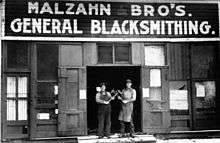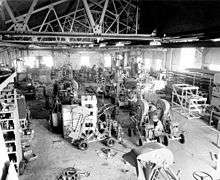Ditch Witch
 | |
| Private | |
| Industry | Construction Equipment |
| Founded | Perry, Oklahoma, U.S. (1902) |
| Founder | Edwin Malzahn |
| Headquarters | Perry, Oklahoma Elverta, U.S. |
| Products | Trenchers, Directional Drilling Machines |
| Website | DitchWitch.com |


Ditch Witch is an American brand of underground construction equipment built by The Charles Machine Works, Inc., which has been in operation under the current name since 1949. The company is based in Perry, Oklahoma.
Ditch Witch machines started in the 1940s when a compact trenching machine was created to replace the pick and shovel for installation of some residential services.
The Ditch Witch organization specializes in the design and manufacture of underground construction equipment. The company is a source for trenchers,[1] vibratory plows, backhoes, electronic guidance and locating tools,[2] horizontal directional drilling systems, drill pipe, downhole tools, chain, teeth and sprockets, vacuum excavators,[3] excavator-tool carriers, and compact utility machines.[4]
History
In 1902, Carl Frederick Malzahn, a German immigrant seeking to escape the harsh winters of Minnesota, moved his family to Perry, Oklahoma, and opened a blacksmith shop with his sons, Charlie and Gus. The business prospered, and several years later, with the advent of an oil boom, it became Charlie’s Machine Shop, specializing in repairs for the nearby oil fields.
Ed Malzahn, Charlie’s son, learned from his elders the process of adapting a business to meet changing demand. In the late-1940s, he began to apply his mechanical engineering degree to a device that he believed would simplify the process of installing residential utility services—electric, gas, and plumbing lines—which at that time involved slow, tedious, pick-and-shovel labor. Working together, Ed and his father Charlie spent months in the family machine shop creating the prototype of the first compact trencher. They would call it the DWP, which stood for Ditch Witch Power.
The first commercial DWP was introduced in 1949.[5] It was the first mechanized, compact, service-line trencher developed for laying underground water lines between the street main and the house. The DWP solved an age-old problem for the utility contractors of its day.
With the growing popularity of the Malzahns’ trencher, Charlie’s Machine Shop became The Charles Machine Works, Inc., which still maintains its headquarters in Perry, Oklahoma,[6] a town of about 5,000 residents in the north-central part of the state. In addition to trenchers, the company today designs and manufactures a wide variety of underground construction equipment bearing the Ditch Witch name.
Tiffany Sewell-Howard, Ed Malzahn’s granddaughter, became CEO of The Charles Machine Works, Inc., in 2005. Now in his 90s, founder Ed Malzahn still serves as company president and chairman of the board.[7]
The Perry, Oklahoma, headquarters of the Ditch Witch organization is on an expansive campus that contains the company’s 30-acre (120,000 m2) manufacturing plant and training, testing, research and product development facilities. Ditch Witch worldwide headquarters employs more than 1300 people.
The Ditch Witch compact trencher has twice been named “one of the 100 best American-made products in the world”[8] by Fortune magazine. In 2002, the DWP was designated a historical mechanical engineering landmark by the American Society of Mechanical Engineers.[9]
References
- ↑ Ditch Witch Trenchers and Plows
- ↑ , Ditch Witch Electronics
- ↑ , Ditch Witch Vacuum Excavation
- ↑ , Ditch Witch Compact Utility Machines
- ↑ , Spring 2008 Underground PDF
- ↑ , Corporate Careers
- ↑ , Ditch Witch Corporate Info
- ↑ , Fortune 100 best American-made products in the world - 1998
- ↑ , Ditch Witch Historical Mechanical Engineering Landmark (ASME)
| Wikimedia Commons has media related to Ditch Witch. |
External links
- Company website
- Encyclopedia of Oklahoma History and Culture - Ditch Witch
- Voices of Oklahoma interview with Ed Malzahn. First person interview conducted with Ed Malzahn, founder of Ditch Witch, on April 14, 2011. Original audio and transcript archived with Voices of Oklahoma oral history project.